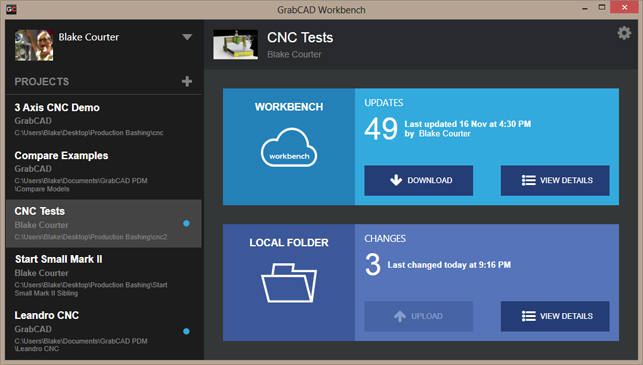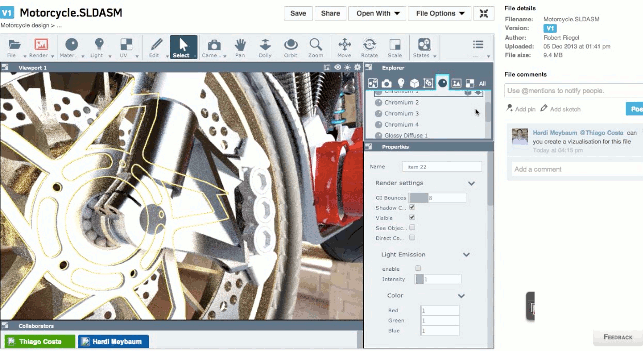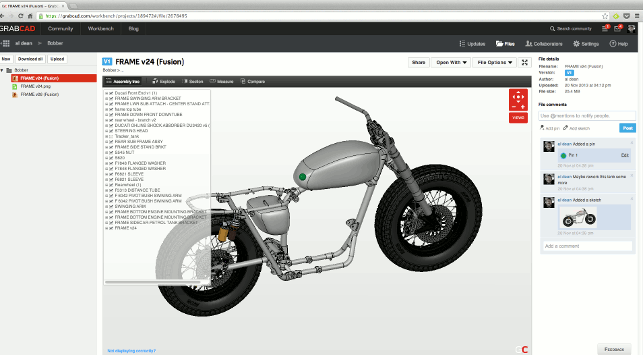GrabCAD Workbench allows you to upload 3D models and share them with colleagues, partners and let them comment, measure/mark up where needed
GrabCAD started out a couple of years ago offering a service that allowed engineers and designers, of whatever level of ability, to upload and share 3D models.
Alongside this, it also set itself up as a market place for engineering projects. The goal was that companies would be able to find people to work on specific projects, without all the ball ache of recruitment.
Companies looking to hire would be able to see the quality of the work done by prospective team members and then move into the hiring process.
GrabCAD also became a place for companies curious about crowd sourcing. Crowd sourcing is the ‘next big thing’ in the technology industry. While the likes of KickStarter are taking advantage of a crowd funded approach to product development, crowd sourcing differs.
The concept is that a company looks to the public (albeit a highly focused portion of the public) to generate new ideas that are restricted by a company’s internal legacy and historical baggage.
In the GrabCAD world, this is enabled by the Challenges part of its website, which helps companies generate new ideas through crowd sourcing. GrabCAD has gained a lot of exposure, working with both small firms and the very large.
For instance, General Electric recently ran a challenge to see what the GrabCAD community could come up with for engine mounting brackets.
Similarly, the Bloodhound SSC team also ran a challenge not too long ago when it was looking for new ideas for a steering wheel concept.
Current challenges range from component design for workstation components through to concept generation of Lomography, an analogue camera movement and community.
Alongside this, the intervening years has seen GrabCAD’s core focus shift and its offering is now very different. So let’s explore how.
Community, then tools
While the public part of GrabCAD (where models are uploaded and shared) remains and drives a huge community of around one million, it has also been fleshing out a set of tools that allows for more private work to be accomplished.
At the same time, it has been tying up with all manner of traditional vendors. Plug-ins or integration are now in Solid Edge, IronCAD and KeyShot. SolidWorks will follow soon.
While the ability to upload data from a CAD system and post it is interesting, the move to integrate and effectively resell Autodesk’s Fusion 360 and AutoCAD 360 cloud-based offerings, earlier this year, showed that there was more to tell.
The company has also been gaining investment (just over $8 million in the last round) and has been bringing new team members on board.
Jon Stevenson, a former VP at PTC, and Blake Courter, the founder of SpaceClaim, are the big names, but the addition of Stuart Reid, formerly of SolidWorks R&D and D-Cubed, proves that the company has much bigger ambitions. And much of those ambitions revolve around GrabCAD Workbench.
Workbench
Launched in 2012, GrabCAD Workbench allows users to upload models from a huge range of formats, including directly from the host 3D design system, and share that data with selected partners and team members.

At present, it supports pretty much every file format you can think of as a direct upload. All of the usual suspects are there in terms of STEP and IGES, but also a good smattering of native file formats, both 3D and 2D.
Once the data is uploaded, the built-in collaboration tools can be used to inspect, to measure, to section, to comment and more.
Partner spaces can be set-up to section off different teams or suppliers. The whole thing seems to work rather nicely. As a result, Workbench has seen some pretty rapid adoption, in both small and large companies alike.
I’ve also heard stories of how the cloudbased solution has been side-stepping larger, more established software vendors’ offerings. Why? Because it is more efficient and more cost effective and, frankly, easier to use.
At the same time, there are also stories of how larger, more cloud-adverse, companies, have outlawed its use.
Collaboration + data management
The latest update, which is cloud-driven so you don’t get releases per se anymore, will be of interest to those looking to solve some of the issues surrounding data exchange with peers.
While the traditional tools found in PDM and EDM and even PLM systems allow connected users to control, manage and share data, they’re often very heavy for what should be a much more flexible and fluid process.
After all, designers and engineers should be designing and engineering, not filling out forms to share data with colleagues. While for some organisations, a formal system with associated workflows/process are what they need, for many, it’s simply too much.
This is seen all across the board — company implements a PDM system and users fight back against it, work around it and generally do anything possible to not use it.
A cloud-based alternative?
So, what GrabCAD has done is come up with a method of using the cloud to make the process of sharing data and managing change a much more effi cient process.
Everyone talks about Dropbox when it comes to data sharing. GrabCAD’s new data management tools work in a very similar manner.

Install the Desktop Sync app, set up a project, then add the data you want to share and the associated folder and then whom you want to share them with. At present, it’s Windows only — I’d expect that to change at some point to also support OSX, giving the platform’s reemergence and popularity amongst newer entrants into the field.
The system then handles the changes using version management, rather than the heavier release management. It also allows users to lock data for editing (or unlock it if someone buggers off on holiday for a week).
A more recent release also included recursive locking, which allows a user to lock out a specific sub assembly for editing, rather than the whole thing.
Everyone else that connects to that project can also sync to the same data.
The system has basic tools to assist with rationalising conflict. In terms of design work, the native CAD system is typically used to edit, but users can also use Workbench’s view, mark-up and collaboration tools to interact with the data.
All of the changes can be documented and made visible to everyone that needs them. After all, it’s the cloud, right? That’s a given.
Tools to support change
Interestingly, the team hasn’t just added in the data control and synchronisation tools, there’s also been work done to make the tracking of changes more visible in terms of geometry edits.
Workbench uses TechSoft3D’s HOOPS technology to efficiently display complex models as well as enabling the mark up.
This has been extended in this latest release to include comparison tools.
Using the ‘Compare’ function, you can pull up two revisions of the same data set and have the system highlight points where geometry has altered, either in geometry or position.
For those smaller edits, you might struggle to find these, but for larger, gross edits, it’s immediately clear where things have changed.
The reason I mention HOOPS is that, with this same core technology under the hood, it also means that the same tools could eventually become available on other platforms, desktop as well as perhaps mobile.
At present, GrabCAD’s iOS app allows you to view and add comments to project data, but it doesn’t have the sophistication of the full browser-based tools. But it is good enough to have a quick peek when you’re out and about or on the shopfloor.
Other partnerships
One thing that GrabCAD has done an excellent job of is partnering with different vendors.

The base level is a plug-in or direct integration into various 3D design systems. There are now tools to directly upload data to GrabCAD from Solid Edge, IronCAD and KeyShot.
The Fusion 360 and AutoCAD 360 partnership took things to a new level and showed how cloud-based services from different vendors could work together in the future.
It’s this service-based connection that will grow as more services become available. A good example is the recently announced partnership with Lagoa.
If you’ve not come across it, Lagoa is a cloud-based rendering service that allows you to take GrabCAD data and initiate a rendering session directly inside the Workbench environment.
Conclusion
It’s obvious that GrabCAD is up to much more than just building a community around the sharing of 3D data.
The simple act of hiring some impressive names in the industry shows that something else has been brewing. The introduction of the data management tools is an interesting one.
From speaking to existing GrabCAD Workbench users, it’s become clear that GrabCAD has built something that people dive into and just use.
There’s no massive infrastructure investment and it tends to grow in an organisation once a few members of a team start running with it. From that alone, the ability to sync your data and control change is a natural progression.
The PLM market has long been due for a shake up. While some companies, who have serious concerns about an intellectual property leak, consider the cloud to be a huge no-no, others consider the ability to work effectively, efficiently and collaboratively more important than overly worrying about security.
Workbench’s data management tools offer something completely different. It’s simple, pretty effective and works how things should. I’d imagine that GrabCAD has more up its sleeve, but at present, with this release/update, I can’t wait to see what it offers up next.
While it’s in Beta, it’s free, but I would imagine that for users of Workbench, the paid options are going to be very attractive — it’s either $25 or $49 a month, per user. The difference is storage (25GB vs 50GB per user) for the most part.
Many are skeptical about how the cloud is going to change the product development technology world and, yes, there are concerns. That can’t be denied. But, ultimately, I believe that a sea-change is coming and coming quickly.
Today’s entrants into the world of design and engineering have a very different perspective on how technology is both sold and used and concerns over the cloud and security don’t fit into that perspective.
Yes, the corporate world will take time to adjust and adapt its processes and workflows, but that change is coming.
As soon as the IT managers of tomorrow come of age, we’ll see a dramatic shift.
In the meantime, smaller companies, those where speed, efficiency and data accessibility are more important, will jump all over tools like this and push their use.
What’s interesting is that, because of GrabCAD’s earliest form, it is already finding, capturing and engaging with these people on a basis that no other CAD vendor has been able to.
So perhaps there is a master plan after all. And you know what? It seems to be working.
| Product | Workbench |
|---|---|
| Company name | GrabCAD |
| Price | From $25 per month |







